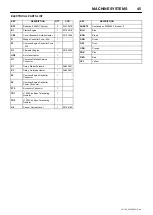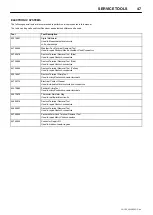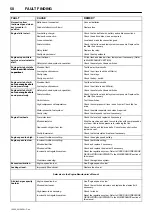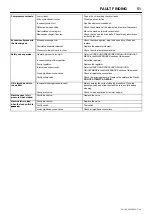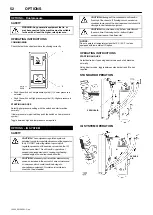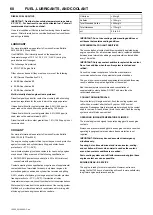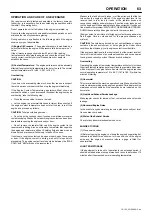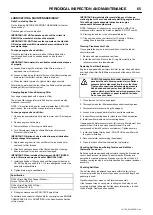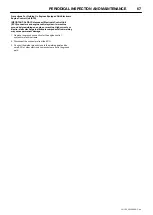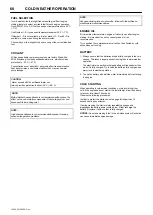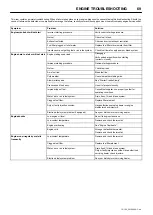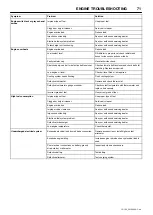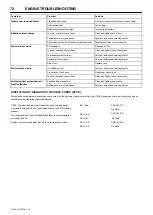
59
FUEL, LUBRICANTS, AND COOLANT
12/150_23136625
−
C en
FUEL
For more information please refer to Cummins Service Bulletin
3379001
−
18(03 Aug 2009)
Consult your local fuel distributor for properties of the diesel fuel
available in your area.
In general, diesel fuels are blended to satisfy the low temperature
requirements of the geographical area in which they are marketed.
Diesel fuels specified to EN 590 or ASTM D975 are recommended.
Cummins Inc. certifies its engines using the prescribed EPA and
European Certification Fuels. Cummins Inc. does not certify engines
on any other fuel. It is the user’s responsibility to use the correct fuel
as recommended by the manufacturer and allowed by EPA or other
local regulatory agencies.
REQUIRED FUEL PROPERTIES
In all cases, the fuel must meet the following properties:
Cetane number of 45 minimum.
Cetane number greater than 50 is
preferred, especially for temperatures below
−
20
C (
−
4
F) or
elevations above 1500 m (5000 ft).
Cold Filter Plugging Point
(CFPP) below the expected low
temperature OR
Cloud Point
at least 5
C (9
F) below the expected
low temperature.
Fuel lubricity
should pass a minimum load level of 3100 grams as
measured by ASTM D6078 or, maximum scar diameter of 0.45 mm
as measured by ASTM D6079.
SULFUR CONTENT:
•
Diesel fuel quality and fuel sulfur content must comply with all
existing regulations for the area in which the engine operates.
•
Sulfur content less than 0.05% (500 ppm) is preferred.
•
If diesel fuel with sulfur content greater than 0.05% (500 ppm) is
used, crankcase oil service intervals may be affected. (See
recommendation for Diesel Engine Oil.)
•
DO NOT use diesel fuel with sulfur content greater than 1.0%.
IMPORTANT: DO NOT mix used engine oil or any other type of
lubricating oil with diesel fuel.
BIO
−
DIESEL FUEL
Cummins Inc. requires that all biodiesel fuel blends be comprised of
petrodiesel meeting ASTM D975, and B100 meeting either ASTM
D6751 or EN14214. Diesel fuel and biodiesel blends up to B5 must
meet the specifications found in Table 1(SBN3379001
−
18):
Cummins Inc. Required Diesel Fuel Specifications. For biodiesel
blends above B5 and up to B20, Cummins Inc. requires that the fuel
meet the specifications outlined in ASTM D7467. These
specifications are summarized in Table 3(SBN3379001
−
18):
Summary of ASTM D7467 Requirements for B6 to B30 Biodiesel
Blends. Reference the official ASTM D7467 standard for more
detailed requirements.
Biodiesel fuel can be blended with an acceptable diesel fuel up to a
20 percent volume concentration (B20) for the QSB6.7 engine.
When using a blend of bio
−
diesel fuel, the engine oil level must be
check daily when the air temperature is
−
10
C (14
F) or lower. If the
oil becomes diluted with fuel, shorten oil change intervals
accordingly.
IMPORTANT: Raw pressed vegetable oils are NOT acceptable
for use for fuel in any concentration.
These oils do not burn completely, and will cause engine failure
by leaving deposits on injectors and in the combustion
chamber.
HANDING AND STORING BIO
−
DIESEL FUEL
WARNING: Handle fuel carefully. Do not fill the fuel
tank when engine is running.
DO NOT smoke while you fill the fuel tank or service
the fuel system.
Fill the fuel tank at the end of each day’s operation to prevent water
condensation and freezing during cold weather.
Keep all storage tanks as full as practicable to minimize
condensation.
Ensure that all fuel tank caps and covers are installed properly to
prevent moisture from entering.
Monitor water content of the fuel regularly.
Fuel filter may require more frequent replacement due to premature
plugging.
Check engine oil level daily prior to starting engine. A rising oil level
may indicate fuel dilution of the engine oil.
When fuel is stored for an extended period or if there is a slow
turnover of fuel, add a fuel conditioner to stabilize the fuel and
prevent water condensation. Contact your fuel supplier for
recommendations.
DIESEL FUEL STORAGE
WARNING: Handle fuel carefully. Do not fill the fuel
tank when engine is running.
DO NOT smoke while you fill the fuel tank or service
the fuel system.
Fill the fuel tank at the end of each day’s operation to prevent water
condensation and freezing during cold weather.
IMPORTANT: DO NOT store diesel fuel in galvanized
containers. Diesel fuel stored in galvanized containers reacts
with zinc coating on container to form zinc flakes. If fuel
contains water, a zinc gel will also form. The gel and flakes will
quickly plug fuel filters, damage injection nozzles and injection
pump.
DO NOT use brass
−
coated containers for fuel storage. Brass is
an alloy of copper and zinc.
Store diesel fuel in plastic, aluminum, and steel containers specially
coated for diesel fuel storage.
Avoid storing fuel over long periods of time. If fuel is stored for more
than a month prior to use, or there is a slow turnover in fuel tank or
supply tank, add a fuel conditioner to stabilize the fuel, prevent water
condensation.
MINIMIZING THE EFFECT OF COLD WEATHER ON DIESEL
ENGINES
The diesel engine is designed to operate effectively in cold weather.
See your authorized engine distributor or servicing dealer for
additional information and availability of cold weather aids.
Use Grade No. 1
−
D Fuel
When temperatures fall below 5
C (40
F), Grade No. 1
−
D fuel is
best suited for cold weather operation.
Содержание 12/150
Страница 42: ...MACHINE SYSTEMS 40 12 150_23136591 C en ...
Страница 44: ...MACHINE SYSTEMS 42 12 150_23136591 C en WIRING DIAGRAM 23296643_B SHEET 2 ...
Страница 46: ...MACHINE SYSTEMS 44 12 150_23136591 C en WIRING DIAGRAM 23296643_B SHEET 3 ...
Страница 81: ......
Страница 82: ......

